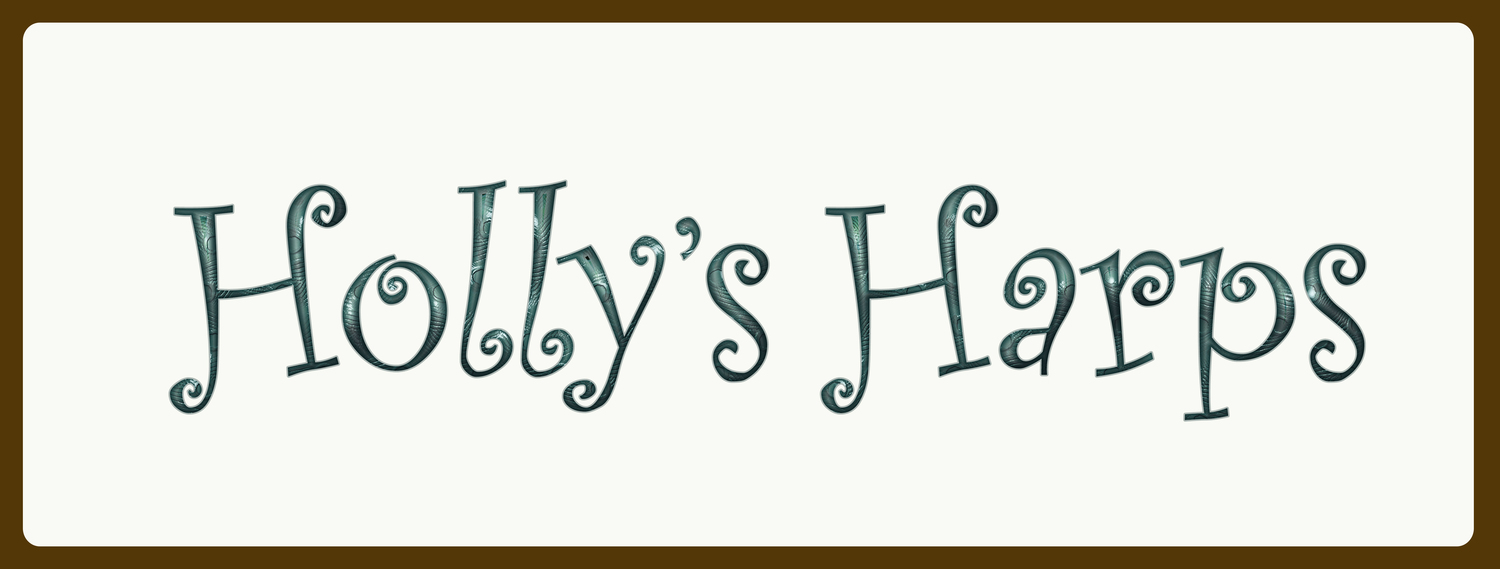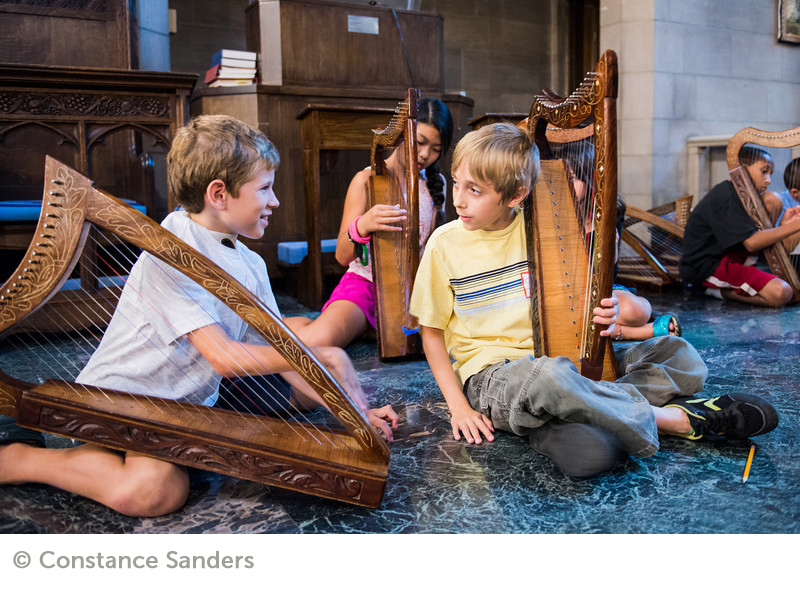Assemblies
1. Assemblies introduce the harp and related topics. In addition to music, an assembly, "The Science and Math of Harp Music," features material rooted in state standards in music, science, math and language arts. Holly engages your students with acoustical science, music, interesting historical tidbits and fun harp facts. Not only do students listen to music in this assembly, they also identify sounds, predict outcomes and solve problems. A question and answer period tops off the session.
- Age groups: Vocabulary and concepts are age-appropriate for each level, so assemblies are conducted in separate sessions for Primary, Intermediate and Middle School students at no extra charge.
- Number of students: Up to 300 within one age group (primary, intermediate or middle school). Under 200 provides an even better experience. There is no extra fee for up to 3 assemblies to serve all three age groups, or to serve large populations.
- Activity
Run Time: Primary assembly: 30 minutes |
Intermediate Assembly:
45 minutes | Middle School Assembly: 45-60 minutes (your choice) - Transition Time: Between two assemblies, allow sufficient time for one group to exit and the next group to be seated. All students should be seated before the scheduled start time, to allow for full program run time.
Hands-on Workshops:
Hands-on harp workshops give every child a chance to play a real harp. Students will experiment with the science of sound, apply musical concepts introduced in the assembly, and use new vocabulary.
Workshops are offered for students who have first attended the assembly for their age group. (In a Full Day program, begin with Assemblies for each age group, and follow up with workshops. )
In every Holly's Harps workshop, your students will play a song. No previous musical experience is required. Intermediate and middle school students can play in harmony and even create a song the way performers did four centuries ago.
- Age groups: Workshops are usually conducted with one grade level per session. In certain situations, sessions are modified to accommodate two contiguous grades (e.g. K-1 or 1-2) or for multi-age Montessori classrooms.
- Number of students: Grades pre-K, K, 1 or 2: up to 60 students maximum. This maximum number is firm because of the number of instruments available. Students work in pairs. Grades 3 and higher: up to 30 students maximum. This maximum number is firm. Each student has her/his "own" harp for the session.
• Activity Run Time: There is some flexibility in workshop lengths to accommodate your scheduling needs.
Grades
Pre-K, K, 1st or 2nd: 20-30 minutes
Grades
3 and higher: 30-45 minutes
Middle
School: 30-60 minutes
- Transition Time: Workshop times include transition time between groups, assuming the harps stay in one place (e.g. classroom, all purpose room, library) and the children come to that location for their scheduled workshop. So you can schedule workshops back-to-back, e.g. 8:30, 9:00, 9:30 etc.
If your school is large and you have only one day, consider:
The Combination Activity is a single session which can replace the Assembly and Workshop only for certain age groups. The Combination Activity combines limited assembly material with a brief, modified hands-on opportunity. It is recommended to help fit in more participants when your school population is large.
• Age groups: This activity is suitable only for children in levels Pre-K, K, 1 and 2. (For grades 3 and above, schedule the separate assembly for their age group, plus the regular hands-on workshop. )
- Number of students: Each Combination session can accommodate up to 60 students in one grade or in two contiguous grades (e.g. Pre-K and K together, or 1 and 2 together). This limit is firm because of the number of harps available. Students work in pairs.
- Activity Run Time: 30 minutes
- Transition Time: The Combination Activity includes transition time between groups, assuming the harps stay in one place (e.g. classroom, all purpose room, library) and the children come to that location for the scheduled workshop. So you can schedule back-to-back, e.g. 1:00, 1:30, 2:00, etc.
Descriptions of Activities
1. Assemblies introduce the harp and related topics. In addition to music, an assembly features material rooted in state standards in science and math. Holly engages your students with acoustical science, music, interesting historical tidbits and fun harp facts. Not only do students listen to music in this assembly, they also identify sounds, predict outcomes and solve problems. A question and answer period tops off the session.
- Age groups: Vocabulary and concepts are age-appropriate for each level, so assemblies are conducted in separate sessions for Primary, Intermediate and Middle School students at no extra charge.
- Number of students: Up to 300 within one age group (primary, intermediate or middle school). Under 200 provides an even better experience. There is no extra fee for up to 3 assemblies to serve all three age groups, or to serve large populations.
- Activity Run Time: Primary assembly: 30 minutes | Intermediate Assembly:
45 minutes | Middle School Assembly: 45-60 minutes (your choice) - Transition Time: Between two assemblies, allow sufficient time for one group to exit and the next group to be seated. All students should be seated before the scheduled start time, to allow for full program run time.
See the Curriculum page for more information about program content.
Hands-on Workshops:
2. Hands-on harp workshops give every child a chance to play a real harp. Students will experiment with the science of sound, apply musical concepts introduced in the assembly, and use new vocabulary.In every Holly's Harps workshop, your students will play a song. No previous musical experience is required. Intermediate and middle school students can play in harmony and even create a song the way a performer did centuries ago.
- Grades Pre-K, K, 1, or 2: 20-30 minutes
- Grades 3 or higher, 30-45 minutes
- Middle school: 30-60 minutes.
- Age groups: Workshops are usually conducted with one grade level per session. In certain situations, sessions are modified to accommodate two contiguous grades (e.g. K-1 or 1-2) or for multi-age Montessori classrooms.
- Number of students: Grades pre-K, K, 1 or 2: up to 60 students maximum. This maximum number is firm because of the number of instruments available. Students work in pairs. Grades 3 and higher: up to 30 students maximum. This maximum number is firm. Each student has her/his "own" harp for the session.
- Activity Run Time: There is some flexibility in workshop lengths to accommodate your scheduling needs. Workshop times include transition time between groups, assuming the harps stay in one place (e.g. classroom, all purpose room, library) and the children come to that location before their scheduled workshop time.
3. The Combination Activity combines limited assembly material with a brief, modified hands-on opportunity. It is recommended to help fit in more participants when your school population is large. It is available only for specific grade levels (see below).
- Age groups: This activity is suitable only for children in levels Pre-K, K, 1 and 2. For grades 3 and above, the full assembly and the regular hands-on workshop are available.
- Number of students: Each combination activity session can accommodate up to 60 students in one grade or in two contiguous grades (e.g. Pre-K and K together, or 1 and 2 together). This limit is firm because of the number of harps available. Students work in pairs.
- Activity Run Time: 30 minutes
Residencies typically include opportunities for many students, and additional activities for a smaller number of students in a residency Core Group. Residency objectives and final program are determined in consultation with educators and parents. Your residency may focus on some or all of these topics:
1. Music First: Uses harp as a classroom-wide instrument and focuses on general music-making. You may top off with a final student performance on harps for families, peers and community.
2. Complete Concert: Students work toward a final performance with the professional ensemble Lyrica. This is usually part of a local concert series, with the children's participation on the second half of the program. (In addition to harps, the following are possible in some locations: recorders, bells, Orff, strings, other instruments, choral singing, dance, sign language.
3. Community Service: As a final project, students take "their" harps to a local senior citizen center. The exact program is developed by the students themselves, considering the specific audience they will work with. Students not only perform for the audience, but also can learn to help others experience the harp for themselves.
4. Faith-Based Residency: You are invited to talk with Holly about building a residency reflecting traditions of your faith and celebrating music as a gift.
5. STEM: A STEM residency features harp as a portal to Science, Technology Engineering and Math. Activities take place in large and small groups. Topics include the science of sound, human hearing, physics of the harp, measuring and presenting data, and the "Harpist, we have a problem" mysteries.
This multi-day STEM residency is much more in-depth than the "Science and Math of Harp Music" assembly. The STEM residency is suitable for students in middle school or higher.










